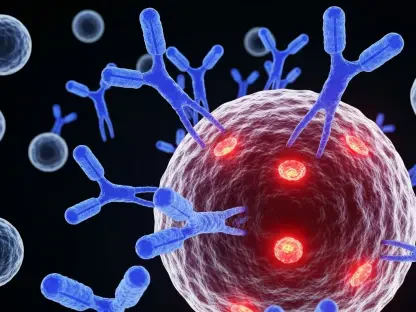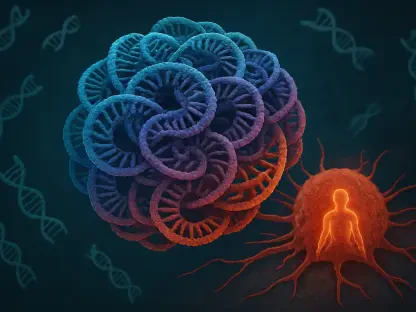The biopharma industry stands on the brink of unprecedented transformation as AI agents promise to redefine how workforce dynamics unfold. Unlike traditional automation methods, AI agents utilize advanced natural language understanding, setting a new benchmark in automation technology. These systems do not rely on rigid programming but offer adaptable and scalable solutions. This article examines AI agents’ transformative potential in the biopharma sector, focusing on their capabilities, financial implications, and how they could reconfigure both task execution and workforce roles.
The AI Advantage in Automation
Transformative Automation Technologies
AI agents signify a fundamental evolution in automation by incorporating natural language understanding capabilities, which positions them above traditional rigid automation tools such as robotic process automation (RPA). This innovation allows AI agents to interact flexibly with complex tasks, going beyond hard-coded abilities and offering robust solutions suitable for diverse biopharma operations. Such flexibility makes these agents instrumental in redefining workers’ roles, assigning more significant tasks previously constrained by the limitations of conventional technology. By understanding various contexts and nuances in communication, AI agents can perform tasks requiring cognitive engagement and problem-solving traditionally reserved for human oversight.
Financial Impact on Biopharma
The insights provided by the Accenture-Wharton study reveal that AI agents could have a critical financial impact on the biopharma industry, with annual value projections ranging between $180 billion and $240 billion. These figures are grounded in enhanced productivity and substantial cost reductions facilitated by AI integration into daily operations. Key areas such as R&D cycles, cost of goods sold (COGS), and accelerated product launches stand to benefit from AI’s ability to manage routine workloads. As a result, human resources are freed to focus on higher-level strategic activities, fostering innovation and efficiency throughout the industry. By optimizing workflows and reducing manual errors, AI agents deliver significant financial gains that bolster competitive standing in the biopharma landscape.
Categories of AI Agents
Utility, Orchestrator, and Super Agents
AI agents are grouped into three distinct categories based on their functional roles: Utility agents perform foundational tasks, Orchestrator agents coordinate complex endeavors, and Super agents integrate multiple functions for high-level problem-solving. Utility agents resemble basic building blocks capable of executing specific tasks independently within larger frameworks. Orchestrator agents play a crucial role by effectively managing intricate projects, delegating tasks, and escalating decisions for human intervention when necessary. These orchestrators function like project managers, guiding processes smoothly yet remaining alert to potential conflicts. Super agents epitomize the merger of various functional units, enabling sophisticated solutions to more nuanced challenges in the biopharma field.
Shifts in Task Management
AI agents executing routine tasks pave the way for strategic transitions of human roles, emphasizing cognitive oversight and nuanced judgment over manual repetition. As AI systems optimize dynamic processes, traditional methods allow for the realignment of research environments, particularly in research and development sectors. This transformation means that AI agents can tackle substantial workloads efficiently, allowing human capital to engage in decision-making that requires a high level of thought and creativity. As the industry adapts to this new model, teams must be prepared to embrace roles that require collaboration with AI for strategic evaluation, fostering environments that leverage both human insight and machine precision.
Immediate Wins from AI Deployment
Enhanced Data Retrieval
One of the most immediate benefits of deploying AI agents in biopharma operations is the enhancement in data retrieval processes, characterized by increased efficiency and accuracy in handling monotonous tasks like document processing. AI agents have proven their prowess in consistently executing such operations, significantly minimizing human errors. For instance, this is illustrated by improvements in health insurance document processing systems where humans only need to intervene in a small minority of cases. By streamlining data retrieval processes, organizations can focus on more substantive work, eliminating repetitive tasks that consume valuable human resources.
Advanced Pattern Analysis
AI agents showcase unparalleled capabilities in identifying patterns on a scale beyond human capacity, substantially assisting biopharma research activities. Through high-grade analytics, AI optimizes processes such as trial design and target ranking, effectively filtering potential dead ends before projects transition into laboratory phases. Their pattern-recognition strengths converge into multifaceted optimizations, refining the identification of viable pathways and addressing complexity within research frameworks. This capacity enables biopharma firms to foresee challenges, prioritize promising research avenues, and accelerate innovation timelines while reducing costly detours inherent in traditional methods.
Revolutionizing Lab Automation
AI agents significantly alter lab automation dynamics by introducing innovative approaches to real-time protocol adjustments during assays. This adaptability surpasses conventional repetitive procedures, enhancing precision and reducing the margin for error. By responding to immediate data during experiments, AI-enabled labs ensure streamlined outcomes through improved mechanisms that prevent unnecessary repetitions. Such revolutionized practices promote effective resource allocation and further intelligence integration within laboratory operations. Biopharma ventures can thus achieve remarkable efficiency, transforming lab settings into predictive and responsive environments aligned with the broader strategic objectives of the industry.
Strategic Human-AI Collaboration
Redefining Workforce Roles
The integration of AI agents reshapes workforce roles, shifting from routine execution to strategic oversight and collaboration. Human expertise remains indispensable, especially in areas requiring ethical considerations or resolving complex anomalies that orchestrator agents cannot address definitively. This transformation underscores the importance of human capabilities in maintaining high-level judgment and decision-making functions, despite AI-driven efficiency. By embracing strategic involvement, biopharma organizations can restructure roles to enhance problem-solving capacities while complementing AI agents’ systematic approach to varied business processes.
Embracing a “Human+ Workforce”
Organizations are encouraged to adopt a “Human+ workforce” philosophy, optimizing task assignments by leveraging comparative advantages between humans and AI agents. This approach requires adaptive infrastructure capable of facilitating large-scale reskilling to accommodate evolving collaborations. By focusing on matching tasks dynamically, teams can foster roles that emphasize synergy between AI competencies and human strategic insight. Building infrastructures geared towards reeducation and skill enhancement ensures the biopharma sector maintains its competitiveness and readiness for AI-related transformations. This balance promises gains in individual work satisfaction while promoting the effective execution of complex organizational strategies.
The Role of Physics-Based Modeling
Industry Trends and Regulatory Shifts
In parallel with AI agents’ advancements, physics-based modeling methods emerge as crucial factors driving change in biopharma practices, notably aligning with regulatory developments like the FDA’s shift from animal testing requirements. Although these initiatives weren’t the primary focus of the Accenture-Wharton study, the industry’s movement towards technological synergies reflects the necessity of scalable modeling alternatives for scientific innovation. Such computational advancements underscore the demand for biopharmaceutical processes to adapt to evolving standards, establishing platforms capable of meeting regulatory guidelines while optimizing efficiency and ethical standards.
Toward Humane Testing Alternatives
The biopharma industry is poised for an unprecedented transformation with the advent of AI agents, promising to reshape workforce dynamics significantly. Unlike traditional automation methods, these AI systems employ cutting-edge natural language understanding, establishing a new standard in automation technology. They differ from previous tools, which depended on fixed programming, by providing adaptable and scalable solutions suitable for the evolving needs of the industry. The article explores the transformative potential of AI agents in the biopharma sector, emphasizing their capabilities, financial impacts, and their ability to redefine task execution and workforce roles. As AI integrates deeper into biopharma, it’s anticipated to revolutionize operational efficiency, enhance decision-making processes, and offer insightful data analyses. This transformation could lead to substantial cost savings and enable more personalized approaches in drug development and patient care, highlighting the evolving symbiosis between AI technology and biopharma innovation.









